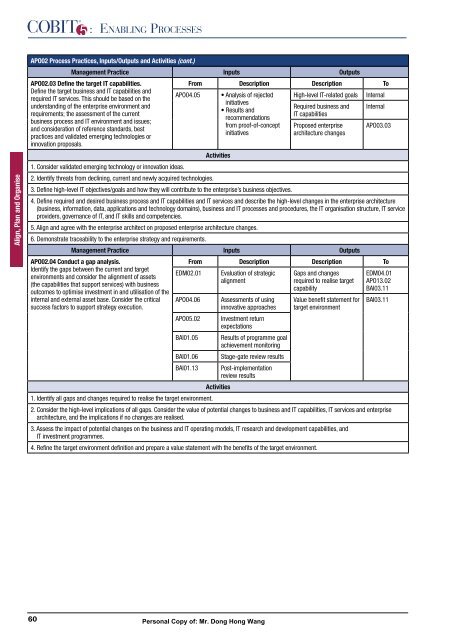Enabling Processes
Enabling Processes
Enabling Processes
You also want an ePaper? Increase the reach of your titles
YUMPU automatically turns print PDFs into web optimized ePapers that Google loves.
Align, Plan and Organise<br />
60<br />
: ENABLING PROCESSES<br />
APO02 Process Practices, Inputs/Outputs and Activities (cont.)<br />
Management Practice Inputs Outputs<br />
APO02.03 Define the target IT capabilities.<br />
Define the target business and IT capabilities and<br />
required IT services. This should be based on the<br />
understanding of the enterprise environment and<br />
requirements; the assessment of the current<br />
business process and IT environment and issues;<br />
and consideration of reference standards, best<br />
practices and validated emerging technologies or<br />
innovation proposals.<br />
From Description Description To<br />
APO04.05 � �������� �� ��������<br />
initiatives<br />
� ������� ���<br />
recommendations<br />
from proof-of-concept<br />
initiatives<br />
High-level IT-related goals Internal<br />
Required business and Internal<br />
IT capabilities<br />
Proposed enterprise APO03.03<br />
architecture changes<br />
Activities<br />
1. Consider validated emerging technology or innovation ideas.<br />
2. Identify threats from declining, current and newly acquired technologies.<br />
�� ������ ���������� �� ���������������� ��� ��� ���� ���� ���������� �� ��� ������������ �������� �����������<br />
4. Define required and desired business process and IT capabilities and IT services and describe the high-level changes in the enterprise architecture<br />
(business, information, data, applications and technology domains), business and IT processes and procedures, the IT organisation structure, IT service<br />
providers, governance of IT, and IT skills and competencies.<br />
5. Align and agree with the enterprise architect on proposed enterprise architecture changes.<br />
6. Demonstrate traceability to the enterprise strategy and requirements.<br />
Management Practice Inputs Outputs<br />
APO02.04 Conduct a gap analysis.<br />
From Description Description To<br />
Identify the gaps between the current and target<br />
environments and consider the alignment of assets<br />
(the capabilities that support services) with business<br />
outcomes to optimise investment in and utilisation of the<br />
EDM02.01 Evaluation of strategic<br />
alignment<br />
Gaps and changes<br />
required to realise target<br />
capability<br />
EDM04.01<br />
APO13.02<br />
BAI03.11<br />
internal and external asset base. Consider the critical APO04.06 Assessments of using ����� ������� ��������� ��� BAI03.11<br />
success factors to support strategy execution.<br />
innovative approaches target environment<br />
APO05.02 Investment return<br />
expectations<br />
BAI01.05 Results of programme goal<br />
achievement monitoring<br />
BAI01.06 Stage-gate review results<br />
BAI01.13 Post-implementation<br />
review results<br />
Activities<br />
1. Identify all gaps and changes required to realise the target environment.<br />
2. Consider the high-level implications of all gaps. Consider the value of potential changes to business and IT capabilities, IT services and enterprise<br />
architecture, and the implications if no changes are realised.<br />
3. Assess the impact of potential changes on the business and IT operating models, IT research and development capabilities, and<br />
IT investment programmes.<br />
4. Refine the target environment definition and prepare a value statement with the benefits of the target environment.<br />
Personal Copy of: Mr. Dong Hong Wang


